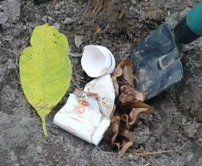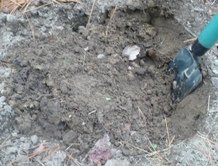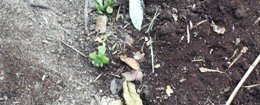





By now, we all know we should be composting. Who hasn't heard of greens and browns, turning the pile, getting it cooking? Yes, "compost happens" but it usually happens slowly unless you engineer it. True efficient composting takes some work, for sure. For quick, hot composting, you have to provide a reasonable balance of nutrients (the green versus brown issue). You have to maintain the pile in a not too dry or too wet state. You have to keep the pile turned, so that the little critters don't smother and die. And small piles, bins, or tumblers of compost are very hard to get working efficiently. The other downside of big compost is the backside, when you have to redistribute this heavy material back out of the pile and all around the yard. There goes another weekend.
Let's be realistic. You may not have the time, acreage or (wo)manpower to deal with that. Yet you feel pangs of guilt with every uncomposted teabag or eggshell. Believe me, I know whereof I speak on this standard compost routine. I've been doing it the old way for years. Guess what? I'm not getting any younger, but I'm trying to get smarter. I'm using another method: putting smaller amounts of organics right in the garden where they'll decompose faster and start to feed plants right away.
That high-maintenance type of composting aims at getting the pile hot, but cold composting has its virtues and its fans. So does vermicomposting, letting earthworms go to work on your juicy scraps. I'm talking about a method that combines cold composting and vermicomposting. Using pit composting, organic matter (your kitchen or garden scraps) is processed in shallow excavations right in your cultivated areas, letting cool soil organisms and worms go to work immediately. All the nutrients released by decay are immediately added to the root zone of your plants.

Now you see it..........................
........................... now you don't.
Pit composting means burying organic matter right in the garden. It'll decompose right there and feed your plants and soil organisms.

A little hole every day or so
You have good organic kitchen scraps, you've got the stylish countertop compost pail. Tote your little bucket with you for a daily check of the garden and offering to the tiny soil gods. Stash a cheapo dollar store trowel behind the perennials. Scrape back a bit of mulch, scoop a small hole and tuck in the kitchen waste and houseplant trimmings. They'll be consumed right there, and right quick, by the native soil minibeasts. Tomorrow, do the same in the next few inches of garden. You can just scoop and fill your way around the landscaping. Eventually all the flowers have gotten a dose of the good stuff, and the beneficial soil microbes have had a small but steady supply of new food. You'll also see far fewer fruit flies when you bury the slimy scraps every day.
A little bigger hole for a month of scraps
Let's say you have plans for planting more than a month in the future. You can take advantage of the lead time by digging a larger hole now and using that pit for few weeks worth of light waste. Go ahead and put your kitchen scraps, handfuls of fall leaves, garden trimmings and coffee grounds into the hole. Work them into the bottom of the hole and layer a little of the excavated dirt back in as you go. Stop filling to allow room for a soil covering over the waste before planting your plant or seeds. Any plant will benefit from this ready supply of nutrients underneath. Squash, cucumbers, pumpkins and their close cousins, all cucurbits, will especially adore this treatment.
A sprinkle here, a sprinkle there
Coffee grounds are enjoying a near-legendary reputation as a soil amendment. You can discreetly carry the week's breakroom grounds home from work without fear of staining work clothes. While grounds are good to use, their best quality may be their aesthetic appeal. They smell and look a lot better than most other organic things you're likely to haul home. That means you can use them as is, right away, no burying needed, and the rich dark brown color instantly makes you look like an expert gardener with incredible soil. Layer the grounds around the base of plants; sprinkle dried grounds over beds of seedlings. Of course, you certainly can use coffee grounds and paper coffee filters in your little and little-bigger holes too. Read a lot more about using coffee grounds in the article, "Happy, Hunting Grounds" by Jeremy Wayne Lucas.
instantly makes you look like an expert gardener with incredible soil. Layer the grounds around the base of plants; sprinkle dried grounds over beds of seedlings. Of course, you certainly can use coffee grounds and paper coffee filters in your little and little-bigger holes too. Read a lot more about using coffee grounds in the article, "Happy, Hunting Grounds" by Jeremy Wayne Lucas.
Small-space gardeners, you CAN compost. You'll just do it in a smaller way to match your smaller garden. Put organic matter right where it's to be used, in your planting areas, and where it goes to work for you right away. Your small soil organisms and plants will love you for it!
___ - ___ - ___ - ___ - ___
Resources* For more information on cold composting and vermicompost as well as pit composting, see US Department of Agriculture, Natural Resources Conservation Service "Composting" (a Backyard Conservation Tip Sheet)Copyright © www.100flowers.win Botanic Garden All Rights Reserved